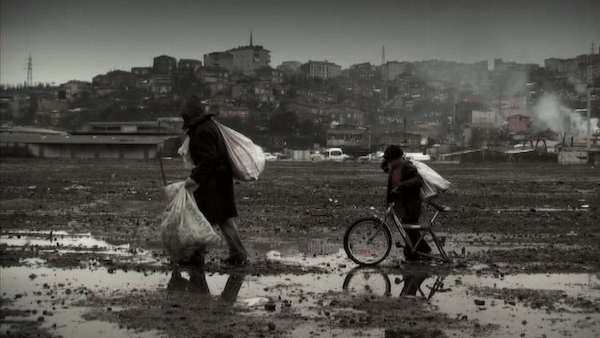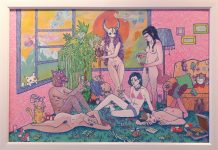Sampling several pieces of work from an artist can give one insight into his or her philosophy. I’ve recently had the opportunity to perform several translations for the up-and-coming filmmaker, Serhat Karaaslan. Serhat grew up in the village of Varto in the province of Muş, located in eastern Turkey. He originally studied pharmacy at Istanbul University, but later pursued a master’s degree in film-making while working as a pharmacist. His most recent short film, Ice Cream, premiered at the Toronto International Film Festival. His earlier short films, Bisiqlet and Musa, have been screened and won awards at international film festivals. He is preparing to shoot his first full-length feature film, Passed by Censor.

Ice Cream is about children in a village trading things to get ice cream from a traveling salesman. Did you do anything similar when you were growing up in Varto?
I remember how ice cream peddlers used to come to our village and all the children surrounded him and tried to get ice cream. Not just ice cream, many things were brought into town this way, but I used ice cream for the film. It could have been anything the children wanted, like a ball or a toy. You know, we were always waiting for something because in the village we didn’t have immediate access to everything. Maybe in the city ice cream is nothing — you can always find it easily. I once traded something more valuable than ice cream: I gave the ice cream peddler two kilos of cheese for just one ice cream. For two kilos of cheese you could probably get a whole lot of ice cream, but you’re just a child and you don’t know. All you want is ice cream.
The film was shot in a real village and the lead character is a child that you met there. Could you talk about how you chose the location and the actors?
I didn’t want to make this movie in Istanbul or even in the surrounding areas because it wouldn’t have been realistic. It had to be in a very remote village, where maybe once a month someone comes from the outside. I didn’t want to shoot in my own village because it has changed over the years, it’s different now than when I was a child. Now, there are many two or three story houses. So, I went to Van. The first day I went to this village and I really liked the contrast between the lake and the very primitive village. They still have stone houses. We could say this story took place in the 1950s and it would be believable, because you can’t see anything modern. You could also think it’s located in India or Iraq. In Toronto, one viewer told me if I hadn’t said it was Turkey, he would have thought it was Iran. I don’t want to make a Kurdish story or a Turkish story; I want to make a human story. I don’t care about where it took place. It’s no time and nowhere.
Tell me about how you chose the boy who played Rojhat, the main character.
I didn’t want to look for a boy in the village because I knew the children there are a bit shy. They aren’t used to strangers. So, I went to Van. I searched on the streets because I knew that the children who sell things there are always in contact with strangers. At first I found a boy, but he ran away when I approached him. I asked another boy selling water on the street, who ended up playing Rojhat, if he knew where the first boy lived. He told me not to look for anyone else because he wanted to act in the film himself. I told him he was a bit too big and he couldn’t. He said if he was big, he would cut his legs off and act. He was very stubborn and determined. I asked if he could take me to the first boy’s house. We got a minibus and we went to the neighborhood. In the minibus, I shot the boy with my camera and realized that he’s very relaxed in front of the camera. Also his personality was very similar to how I had written Rojhat in the script. When we got off of the bus, he pointed out the first boy’s house. I said, “Let’s not go there. Where is your home?”

Ice Cream is your first film shot in Kurdish, your native language. After making films Turkish, was the experience of making this one different?
For me, it doesn’t matter which language it is because cinema is also a language. I can make a film in Kurdish, Turkish, Arabic, without dialogue, it doesn’t matter. Of course, my mother tongue is Kurdish and if I’m going to make a movie in the East or about Kurds, it would have to be in Kurdish. Otherwise, it would be very fake.
My native language is Kurdish but I was educated in Turkish. My Turkish, unfortunately, is better than my Kurdish. The dialogue in the movie isn’t too complicated, and I could write it pretty easily. But if it were a very long, literary dialogue it would be a bit difficult. Sometimes I read in Kurdish, and some of the words aren’t used in the village or in our daily life. I can’t use these words very easily because I haven’t ever used them before. This is one of the many reasons why it’s not easy for the Kurdish language to be permanent in our cinema. It will take a long time, after many movies have been made.
So, you’re saying that there isn’t an established Kurdish cinema culture?
Kurdish people live in four different countries and there are several dialects of the Kurdish language, so it can be difficult to speak of a unified “Kurdish cinema culture”. For Kurdish cinema in Turkey I can say yes, it’s a relatively new genre; also, it’s very new in literature. Kurdish people have long been occupied with conflicts and war, and they’ve rarely had time for cinema, literature etc. Also, there is the storyteller we call ‘dengbej‘ — this storyteller is a very important person in Kurdish culture. The stories of the Kurdish population have been told by dengbej for centuries.
Could you talk more about the storyteller in the village?
I remember, when television still wasn’t really available, all the people in the village gathered and the old people told stories. In the beginning of the 1990s, TV started to come to the village, but we didn’t always have electricity. When the electricity was cut off, people again gathered and told stories. One of them was Mem u Zin, a love story, like a Kurdish Romeo and Juliet. It’s very dramatic, very emotional. Whenever someone told this story, all of the people started crying, I remember. Also, the next day, I really wanted to retell the stories to the other children. I wanted to be a storyteller, you know. Maybe this is the reason why I wanted to make movies.
What did you learn from this project that you might use in other film projects going forward?
When I was preparing for this film, I constantly debated whether to use a steady camera or to use a shoulder camera. With a steady cam, all of the frames are very stable and it looks perfect. On the other hand, if I use a shoulder cam, some shots might be very difficult to watch because it’s shaky. The shoulder camera would be more realistic, however, so I used it. In Toronto, some viewers said that when the film started with the shaky camera, they felt like they were in the village, behind the boy as he ran. I’m satisfied with the results. If you are starting out in cinema, taking risks is a good thing. If you don’t take risks, you may be able to make a very good-looking movie, but it might not be unique.
You can read Part 2 of this conversation here!
Dayla Rogers is a contributor to Yabangee










Very good job!!
What a wonderful interview! I was especially interested in the storytelling in the village. Looking forward to Part 2.
[…] Read Part 1 of this interview here! […]
[…] and will screen on Wednesday, March 18 at 13:00 and Sunday, March 22 at 20:30. Click here to read Serhat’s interview in which he discusses the making of ‘Ice […]
[…] On Wednesday 6 January Ezel Akay, acclaimed director of Hacivat ve Karagöz Neden Öldürüldü? and Yedi Kocalı Hürmüz will host the screening of a selection of highly successful shorts from around the world. The event is organized by Fil’m Hafızası, a Turkish website for cinema enthusiasts. Among the shorts featured is Ice Cream by Serhat Karaaslan. Check out our 2014 interview with him here. […]